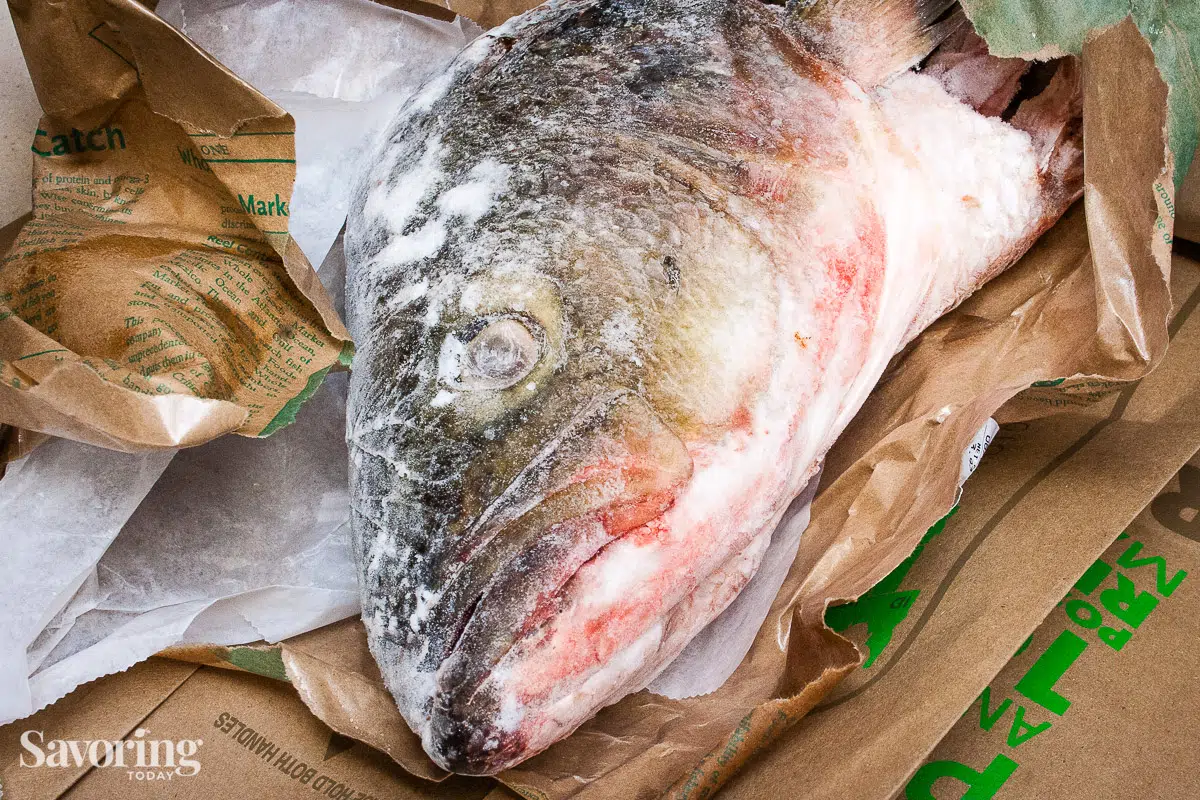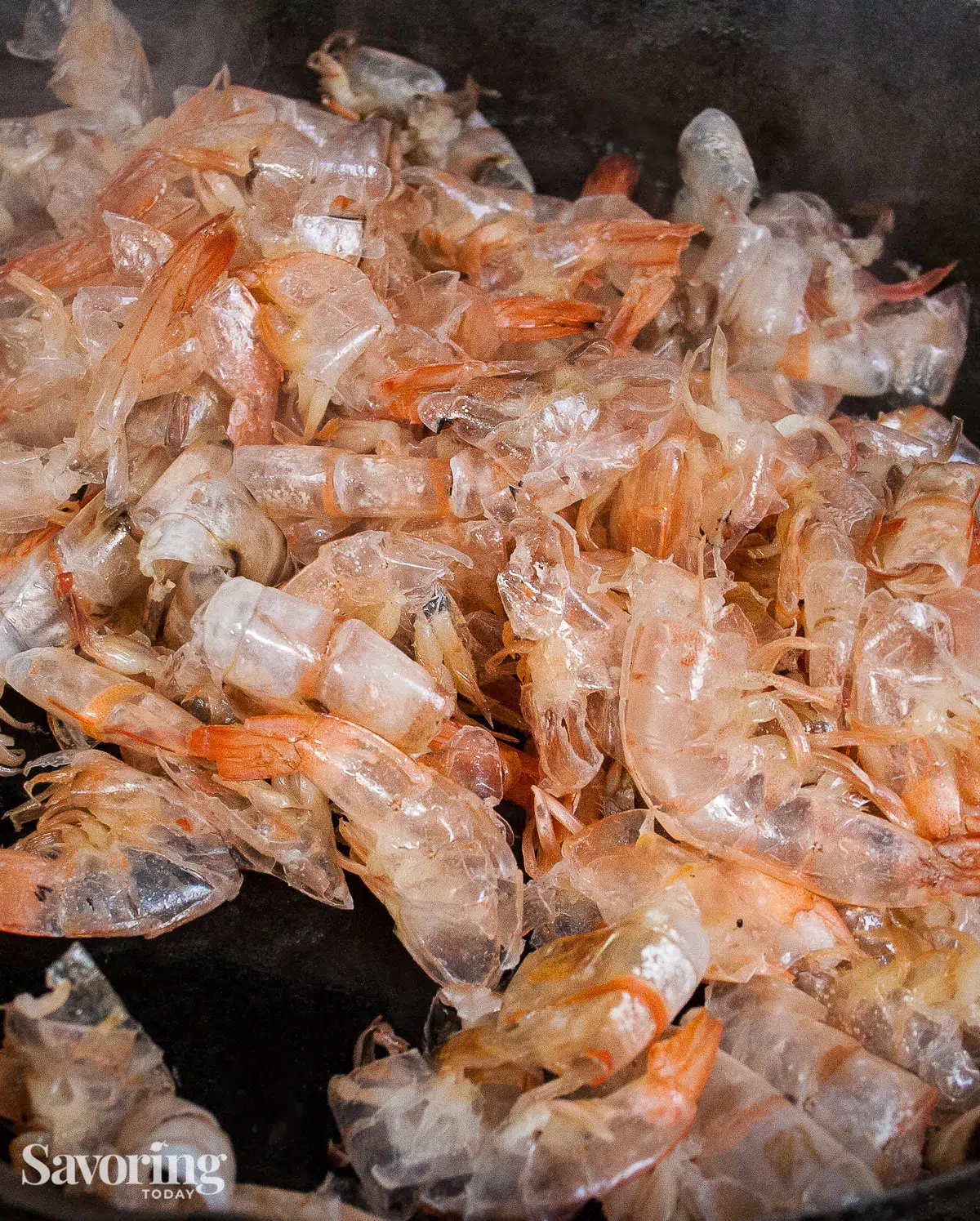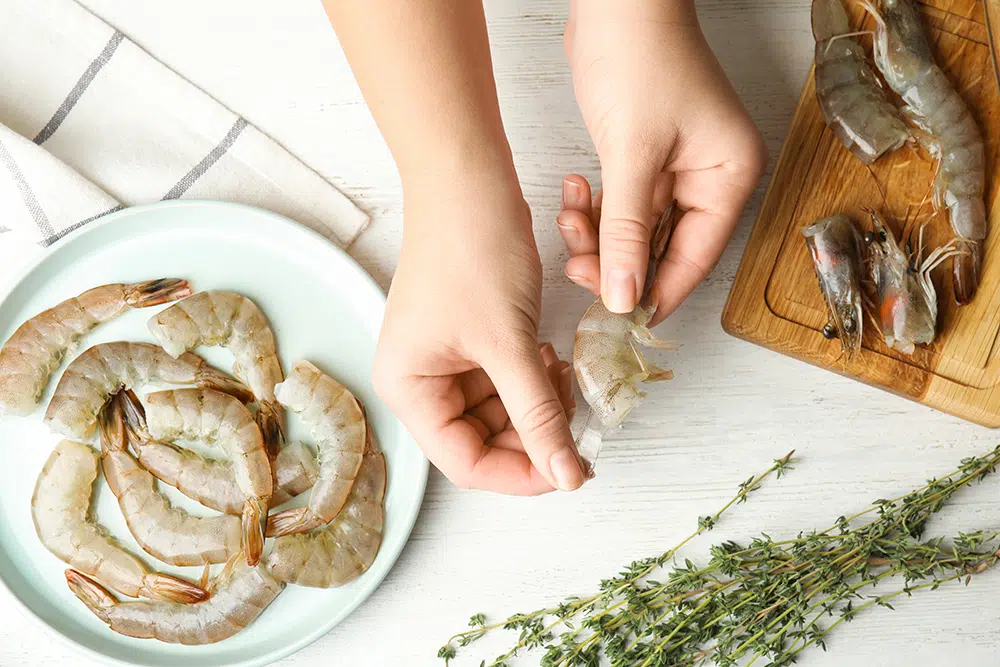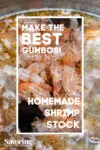Homemade shrimp stock is a crucial element in making the most delicious soups, gumbos, and stews.
This stock is easy to make and so flavorful—make a quick batch anytime you have shells from fresh shrimp.

Homemade stock is a crucial element in delicious soups and stews. This recipe is inspired by Emeril’s Rich Shrimp Stock and is the base for Cajun Shrimp Stew.
Here in Colorado, it is not always easy to source shrimp with heads for the stock. The few shells from the shrimp for the Cajun stew were not enough for a great stock. To improvise, I asked for a fish head at the seafood counter, which they had.
Most large grocery chains now have their fish products trimmed at a larger facility and shipped to them case-ready. Availability of scraps and carcasses can simply be an issue of timing, though a good fishmonger will usually have something to offer in their freezer. It’s worth asking.

A general rule of thumb is 1 to 2 pounds of shells to 3 to 4 quarts of filtered water.
Clam juice or crushed anchovy mixed with vegetable stock is a suitable substitute for shrimp stock when you need it fast.
Store homemade shrimp stock in the refrigerator for 3 days or freeze for up to 3 months for best results.
Store stock in a wide mouth jar (no shoulders), air-tight container, or freezer zip-type bag. Use within 3 days when fresh, or freeze for 3 months in containers with headspace, or up to 6 months in freezer bags if the air is removed.

How to Boost Flavor in Fish Stock Without Fish Heads
Don’t have enough shells? No worries! You can still enhance the flavor of shrimp stock with a dash of one of the following:
- fish sauce
- bonito (we use this in Pad Thai too!)
- clam juice
- mashed anchovy
- fish base bouillon
Note: All these flavor-boosters contain sodium, so if using any of these, omit the salt from the recipe as written, or add it at the end to season the stock, if needed.
Allowing a few extra minutes for the stock to reduce will also deepen flavors, but you may want to open a window so the house doesn’t hang on to the aroma. (Just sayin’)

This post may contain affiliate links. See our disclosure policy for more information.
How to Make Homemade Shrimp Stock
1. Use the shells, not the meat.
The shells (and heads) are all you need for flavorful shrimp stock. When prepping shell-on shrimp, save the shells and store them in a zip-type freezer bag in the freezer until ready to make the stock.
Collect spent vegetables too! Did the celery go limp? Carrots lost their vigor? Is fresh thyme not so fresh anymore? Wash and peel as necessary, chop, and toss in a freezer bag for stock.
Stock is intended to be a foundation or base for other recipes, so mild aromatics and herbs are ideal for a clean shrimp flavor to shine through.
Best add-ins: onions (anything in the onion family), celery, carrots, garlic, thyme, and parsley.
2. Gather the basic equipment
- Roasting pan
- 6-8 quart soup pot
- Strainer and (optional) cheesecloth to lay in the strainer to catch the fine sediment.
- Container large enough to strain the stock into and hold the stock while cooling, like a Rubbermaid Commercial Clear.
- Scoop to transfer the contents to the strainer.
- Containers, jars, or freezer bags for storage. (Don’t forget to mark the date.)
3. Make the Stock
- Toast the shells to enhance flavor.
- Roast the vegetables depending on the type of recipe. Roasting the vegetables deepens the flavor and color of the stock, which is ideal for gumbo or strongly flavored dishes. However, if you’re making a clear soup base with more nuanced, delicate flavors, roasting the vegetables is not the best approach.
- Adding a small amount of acid like white wine, lemon juice, or apple cider vinegar will brighten and clarify the flavor.
- Skim off the scum that rises to the top. It won’t hurt anything; it’s just a collection of proteins and will strain off.
- Don’t boil; only bring it to a boil and reduce the heat to simmer.
- Close the door to your bedroom and bathroom so your clothes and towels don’t smell like fish soup. (Been there.)
4. Strain and Cool
- When ready to strain the stock, grab a rimmed baking sheet for the strained contents so they can cool completely before discarding.
- Transfer the contents with a 2 or 4-cup scoop rather than trying to pour from a heavy pot with splashy hot bits into a strainer precariously balanced over a bowl.
- Don’t press the contents when straining; let gravity do the work to avoid tiny bits of sediment pressing through. *You can eat the strained vegetables and meat left behind if the taste and texture are appealing.
- Cool as quickly as possible if not using the stock right away. Use an ice water bath in the sink, or add a few ice cubes and pour into a shallow container to cool within 2 to 3 hours. Don’t put hot stock in the fridge; it will bring down the temp in the entire fridge to potentially dangerous levels.
Storing Shrimp Stock
- Store homemade shrimp stock in the refrigerator for 3 days or freeze for 3 months for best results.
- Freeze the stock in various increments—ice cube tray squares (tablespoons); 1/2 cup, 1 cup, or 2 cups are common in recipes; 6-8 cups work best for soups.
- Containers and jars should not be filled to the top so the liquid has an inch of space to expand. Only use glass jars with straight sides (no shoulders) in the freezer to avoid the risk of breakage.
- Storing stock in freezer bags that can lie flat is ideal. Remove as much air as possible before sealing. To prevent the bags from sliding into lumps, place the filled bags flat on a rimmed baking sheet.

TIPS & Variations
- Freezing stock in zip-type bags: Stock in a freezer bag will almost always leak when defrosted, and in my experience, bags can’t be trusted; there’s always a compromised corner.
- It’s important to not over-fill the bags—2-4 cups per quart and 6-8 cups per gallon bag doesn’t stress the seams and defrosts quickly.
- To save space in the freezer, reduce the stock further after straining and discarding the solids. Just add water to the defrosted stock to the concentrated liquid as needed.
- Defrost on a rimmed pan to catch leaks, and resist the urge to defrost in a bowl of water unless you want your stock watered down (remember, bag corners can’t be trusted).
10 Delicious Ways to Use Shrimp Stock
Easy Homemade Shrimp Stock
Ingredients
- 1 to 1 ½ pounds shrimp shells and heads , or other fish heads
- 1 tablespoon avocado oil
- 1 large onion , unpeeled, roughly chopped (the onion peel deepens the color of the stock)
- 2 ribs celery , coarsely chopped
- 2 large carrots , coarsely chopped
- 2 cloves garlic , peeled and smashed
- 2 bay leaves
- 3 sprigs fresh thyme
- 1 handful fresh parsley coarsely chopped
- 2 teaspoons black peppercorns
- 1 teaspoon salt
- 3 1/4 quarts filtered water
- 1/4 cup white wine (Optional)
Instructions
- Rinse the shrimp shells and heads in a large colander under cold running water and allow to drain.
- In a large soup pot, heat the oil over medium-high heat. When hot, add the shrimp shells and cook until the shells are pink and fragrant, 4 to 6 minutes.1 to 1 ½ pounds shrimp shells and heads, 1 tablespoon avocado oil
- Add the remaining ingredients, except the water, and stir to combine. Pour in water and bring to boil over high heat, then reduce heat to med-low to maintain a low simmer for 45 minutes to 1 hour (this may take longer if using larger fish heads like salmon). Skim any foam that comes to the surface.1 large onion, 2 ribs celery, 2 large carrots, 2 cloves garlic, 2 bay leaves, 3 sprigs fresh thyme, 1 handful fresh parsley, 2 teaspoons black peppercorns, 1 teaspoon salt, 3 1/4 quarts filtered water
- Stir in the wine the last 5 minutes of cooking. Taste and add more salt if the broth tastes flat to enhance the natural flavors.1/4 cup white wine
- Strain the stock through a fine-mesh sieve into a large heat-safe container and allow it to cool completely if not used immediately. NOTE: Cool as quickly as possible using an ice water bath in the sink, or add a few ice cubes to the stock and pour into a shallow container to cool within 2 to 3 hours. Don’t put hot stock in the refrigerator, it will bring down the temp in the entire fridge to potentially dangerous levels.
Notes
- Store homemade shrimp stock in the refrigerator for 3 days or freeze for 3 months for best results.
- Freeze the stock in various increments—ice cube tray squares (tablespoons); 1/2 cup, 1 cup, or 2 cups are common in recipes; 6-8 cups work best for soups.
- Containers and jars should not be filled to the top so the liquid has an inch of space to expand. Only use glass jars with straight sides (no shoulders) in the freezer to avoid the risk of breakage.
- Storing stock in freezer bags that can lie flat is ideal. Remove as much air as possible before sealing. To prevent the bags from sliding into lumps, place the filled bags flat on a rimmed baking sheet.
- To save space in the freezer, reduce the stock further after straining and discarding the solids. Just add water to the defrosted stock to the concentrated liquid as needed.


Laura says
Very easy!! Great fresh flavors and delicious!!
Beginner Food says
Would love to try this since I’m planning on making more seafood dishes this month, and then freezing the rest for future use, although I must remember to put a date on the bag
Barton Ellis says
Thank you so much for this great recipe!
Judy Purcell says
Hi Barton, You’re welcome! I was grateful to be able to share it with permission. Thanks for taking the time to come back and let me know how it worked for you. 🙂
becki rinner Doege says
Waxy scum when makin my stock! I have made shrimp stock for years and never seen this! I could barely clean the wax off the pot! Is this an indication of bad shrimp??
Judy Purcell says
Hi Becki! I’m sorry for the delay in my response, but I’ve been researching your question. I have never seen a waxy scum from shrimp stock either, so I’ve searched high and low for the answer. I wondered if it was a higher concentration of fat, antibiotic or some other treatment on the shrimp, or if the stock boiled too hard, but do not have any conclusive information for you. I don’t know. If you purchased the shrimp from a familiar source, I would ask them. This is one of those things that hasn’t happened enough to get the attention of google search (and I’ve used every combination of terms I can think of), but you may find an answer by asking the merchant. I’ll ask around too and let you know if I get a good answer!
Erich says
Can you puree all the solids from the stock to fortify and deepen the richness of this stock or will the heads and shells not become smooth?
Judy Purcell says
Hi Erich, that’s a great question. I wouldn’t try to puree the solids because of the texture, as you mention. To deepen the flavor of the stock you can let it cook a little longer with the solids in there, strain, and then let is simmer to condense even more. This is the best technique to enhance its flavor. Also, adding just a little salt will bring out the flavor of stock as well.
Let me know if that helps and how it turns out for you.
Lilly says
A great guide for making my own shrimp stock! Thanks!
Emugg says
How funny, I was looking to see if using the heads of the shrimp would make a better stock than just using the shells. I just clicked the link without realizing it was to the site of my favorite “Osso Buco lady.” Your site is one of only three I have on my toolbar and USUALLY go to first. However I didn’t think to look for something Cajun here lol.
Your osso buco recipe though is still one of my favorites.
Judy Purcell says
Emugg, thank you for your kind comment, it makes my day to hear from readers. There are a few Cajun recipes here, it is certainly some of my favorite food to savor. Glad you found what you were looking for, have a great weekend. 🙂
thedrivencook says
This looks good- if only I wasn’t allergic to shellfish!
Judy says
Ashley, you can leave out the shrimp and simply make it fish stock. I also made suggestion on the Cajun Shrimp Stew post to switch out the shrimp with firm white fish–it would be just as delicious.
Karen says
Homemade stock makes such a difference in a recipe. I have used fish heads for stock just once. I was asked at the fish counter if I wanted the eyes removed and of course I said “yes, please”.
Judy says
Karen, I cooked my first fish head last year for Bouillabaisse … didn’t think to ask for that! The kids thought it was pretty cool to see the eye floating in it, just made me squeamish, so I let my husband strain it (ha!). Thanks for the tip!
ChgoJohn says
I’ve a bag of shrimp shells & heads in my freezer, just waiting to be made into stock. It’s always best when homemade and you’ve shared a great recipe. Thanks.
frugalfeeding says
Stock really does make all the difference as most of the body of the dish comes from it. Looks really great.
rsmacaalay says
We do nearly the same thing for shrimp stock the only difference is that we pound the heads with mortar and pestle to extract the juices inside them
Judy says
I can see how that would make a difference, unfortunately, I didn’t have the shrimp heads, but my fish head fell apart nicely 🙂
Rufus' Food and Spirits Guide says
You are so right. Stock makes all the difference. Love the picture of the fish head.
Judy says
My kids can be so silly–glad she gave me permission to put that one in there. Made me laugh.
mjskit says
You are absolutely right that homemade stock is crucial to soups and stews!!!! While you were making this wonderful looking shrimp stock I was making chicken stock. 🙂 Can’t wait to see the Cajun Shrimp Stew!
Nelly Rodriguez says
Gorgeous and great idea adding the head!